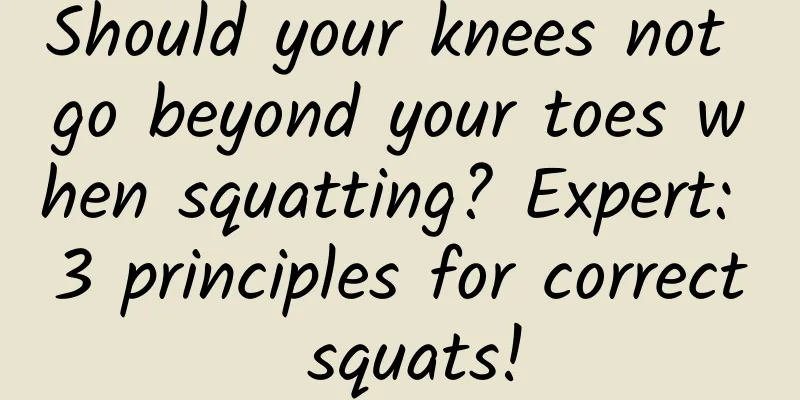Should your knees not go beyond your toes when squatting? Expert: 3 principles for correct squats!

|
Whether it is to improve athletic performance, sculpt body lines, or prevent sarcopenia, "squats" have almost become a national sport. I believe that many people must have been taught that "the knees should not exceed the toes" when they first started practicing squats, but experts say that this concept is outdated! Everyone can squat, but is it an iron rule that the knees should not exceed the toes? The squat movement is like the horse stance in Chinese martial arts. It not only strengthens leg muscles and prevents sarcopenia and falls, but also has a training and sculpting effect on the buttocks and core muscles. Practicing it every day can even improve cardiopulmonary function and delay aging, with many health benefits. What’s special is that squats don’t require tools or a place to exercise like many other exercises. You can do it anytime and anywhere, so almost everyone can easily learn it. However, there is actually a lot of knowledge behind squatting, and the wrong squatting posture can easily hurt your body. Among the precautions for squatting, the most controversial one is "Can the knees go beyond the toes?" Regarding this question, American chiropractic doctor Zhang Xuanbin directly gave the conclusion: "Yes!" Excessive restriction of knee position may cause spinal health problems Dr. Zhang Xuanbin further explained that when he was in school, professors did teach that when squatting, the knees should not exceed the toes, otherwise it would easily increase the pressure on the knees and increase the risk of knee injuries. However, this idea has been overturned in recent years. The deeper you squat, the more your knees will eventually move beyond your toes in order to maintain your center of gravity. Moreover, the world's top weightlifters have also found that when they squat to lift weights, the incidence of knee injuries is not increased because the knees extend beyond the fingertips. The medical community generally believes that if the knees are excessively restricted from going beyond the toes, it may cause injuries to other parts of the body due to improper pelvic and lumbar compensation. When practicing squats, instead of obsessing about the relative position of your knees and toes, it is better to learn the correct starting position first. For example, if a person has naturally long calves, the knees will tend to extend beyond the toes when squatting. If you force the knees to move behind the toes, it will not only increase the pressure on the hip bones, but may also cause the upper body to lean forward excessively in order to balance the body, thereby increasing the pressure on the lumbar spine. If you already have spinal problems, it may also cause disc compression or disc slippage. Learn it now! 3 principles of correct squat 1. Use the buttocks as the starting point Dr. Zhang Xuanbin emphasized that when practicing squats, instead of being obsessed with the relative position of the knees and toes, it is better to first learn the correct starting movement: when squatting, imagine that there is an invisible chair behind the body, with the hip joint (or in plain words, the buttocks) as the starting point, straighten your back and then slowly sit down. If the knee is used as the starting point, the knee is usually prone to exceed the toes, and the knee is also prone to bear greater pressure when adjusting the posture, which may lead to injury. 2. Pay attention to the angles between the lower limbs and upper body Once you have learned the correct starting position for the squat, you can gradually adjust your posture according to your personal situation. Dr. Zhang Xuanbin said that when squatting, the shin bone and upper torso are parallel to each other, and the thigh bone and the ground are also parallel to each other. This parallelogram-like state is the most ideal and stable posture. In addition, the study also found that when the knees are bent about 80 degrees, the quadriceps femoris in the front of the thigh are best trained; when the knees are bent more than 90 degrees, the gluteus maximus in the buttocks is best trained. Therefore, it is recommended to control the knee bending between 80 and 90 degrees when squatting. 3. Your feet should be shoulder-width apart. As for squats, how far apart should your feet be? It is recommended to keep your feet shoulder-width apart. If the feet are too far apart, the knees will easily go beyond the toes when squatting; if the feet are too far apart, the toes will easily retract inwards and form an "inward-facing" position when squatting, increasing the pressure on the medial knee ligament and meniscus. In principle, everyone can do squats, but if you have a known joint disease, you should consult an expert before exercising. Can everyone do squats? In special cases, it is advisable to consult an expert first Dr. Zhang Xuanbin said that in principle, everyone can do squats, but if you are known to have joint diseases, such as knee arthritis, or have had an artificial knee or hip replacement, you should be particularly careful. When you first start practicing, you can also use the "wall method", with your back against the wall, with your heels about 0.5 to 1 foot length away from the wall. Imagine there is a chair behind you, and then slowly sit down with your buttocks; or you can use the "object support method", holding on to furniture with your hands while squatting to increase your body's stability and reduce muscle soreness caused by excessive exertion of the buttocks and thighs. It should be noted that if you experience pain and discomfort when practicing squats that does not subside for a long time, do not think that it is just muscle soreness. Be careful that it may also be a joint injury or meniscus damage. It is recommended to seek medical examination and treatment as soon as possible. Before practicing squats in the future, you should consult an expert for advice and choose a squat posture that is safer and healthier for you. |
<<: "Sour cabbage" is a good stomach and intestines dish that will make you drool.
>>: Is black tea better or green tea better? Which type of tea is better?
Recommend
Winter is a good time to lose weight! 4 physiques do this to lose weight easily
Let me tell you a good news, winter is actually t...
What are the causes of irregular menstruation? What are the dangers of frequent irregular menstruation?
Many female friends tend to ignore irregular mens...
Can multiple uterine fibroids cause miscarriage? How to treat uterine fibroids?
Uterine fibroids are very serious and have a high...
How to prevent cervical erosion?
Cervical erosion is a gynecological disease. Many...
Lose weight without hibernation! Secret weapon: Vitamin B supplementation
There is no holiday for weight loss, especially w...
Obesity comes from the mouth! Is the brain's appetite monster out of control? Doctor: 4 tips for weight loss management to combat obesity
Have you tried many ways to lose weight, but alwa...
Is the French food paradigm shaking? Dietary inequality exceeds that of the United States
France is not only a tourist destination, but als...
How should women with premature ovarian failure be treated?
In addition to amenorrhea, only a few patients wi...
What are the best treatments for female cervical erosion? Five methods are recommended for treating female cervical erosion.
What are the best ways to treat cervical erosion ...
Cold rice is low in calories, can it help control weight? The real killer of starch that causes obesity is…
When it comes to eating, everyone likes to eat ho...
Patients with functional uterine bleeding should pay attention to iron supplementation in their diet
Because functional uterine bleeding often causes ...
Losing weight through exercise is so boring~ Burning fat happily with "Scissors, Rock, Paper" is more exciting!
Are you still fighting against stubborn fat on yo...
How to prevent bacterial vaginosis
In recent years, the incidence of vaginitis has b...
Experts teach you how to treat primary dysmenorrhea
According to recent surveys and studies, dysmenor...
Sex consumes calories equal to 1 bowl of rice. Famous weight loss doctor: More "stimulation" helps burn fat
Can eating fried rice often help you lose weight?...









